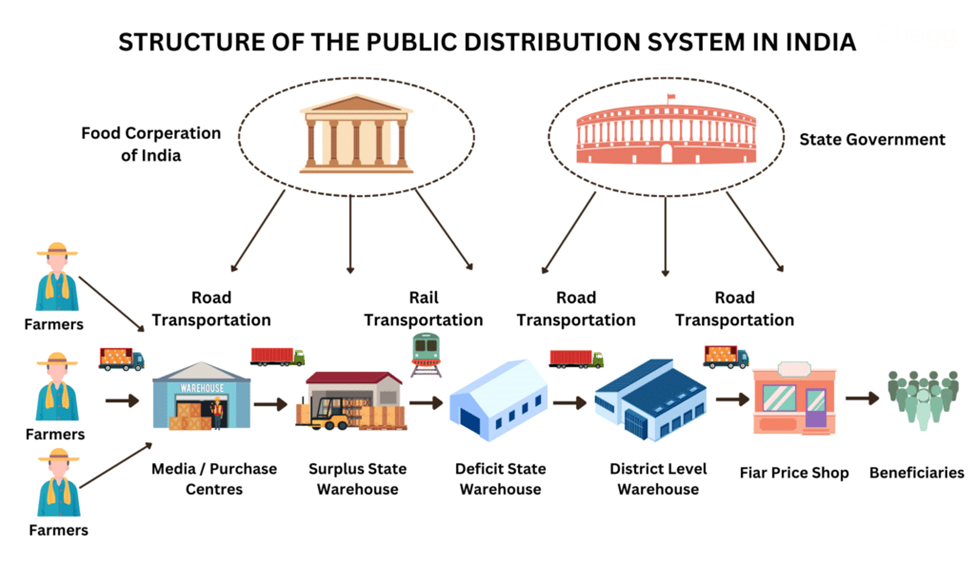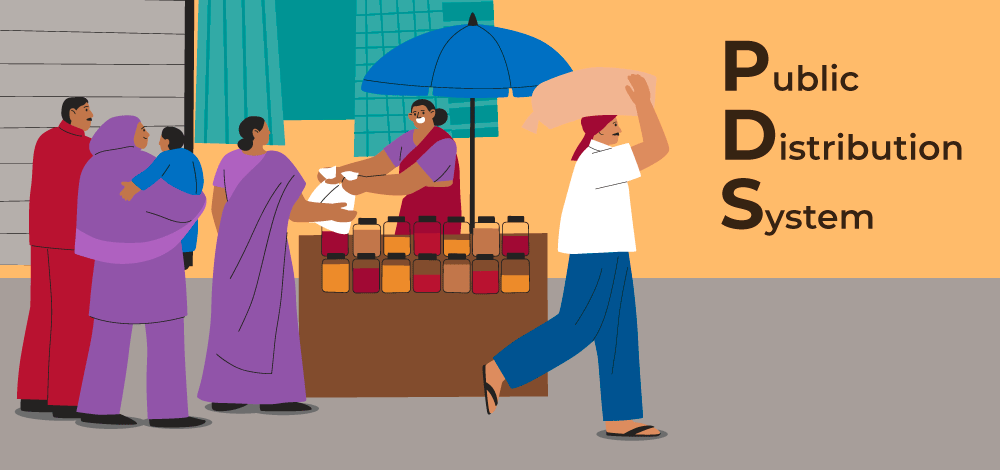Context:
The Public Distribution System (PDS) is one of the largest government mechanisms for ensuring food security in India. Serving over 813.5 million people, it is among the world's largest food distribution programs. The PDS provides subsidized food grains to the economically disadvantaged, making it crucial for combating hunger and malnutrition in India.
Historical Context and Evolution
The PDS began during the Second World War when food supplies were scarce, and the government introduced food control mechanisms. The Bengal famine of 1943 highlighted the need for a formal food distribution system. Over time, the PDS expanded, with the Revised Public Distribution System (RPDS) in 1992 focusing on remote areas, and the Targeted Public Distribution System (TPDS) in 1997 targeting Below Poverty Line (BPL) families. In 2013, the National Food Security Act (NFSA) extended food coverage and made food a legal entitlement for a significant portion of the population.
Objectives of the PDS
The primary objectives of the PDS are:
- Provide essential food items at affordable prices: Aimed at alleviating food insecurity among vulnerable populations.
- Stabilize prices: PDS helps control the market prices of essential commodities, ensuring price stability.
- Prevent hoarding and black marketing: By ensuring a steady supply of food grains, PDS curtails market manipulation.
- Combat hunger and malnutrition: PDS targets food insecurity, especially in disadvantaged communities.
Functioning of the Public Distribution System
The PDS operates in four key stages: procurement, storage, allocation, and distribution.
1. Procurement of Food Grains
The government, through the Food Corporation of India (FCI), procures food grains at a Minimum Support Price (MSP) to ensure fair compensation for farmers. This also helps in stabilizing market prices and ensuring adequate food supply, especially in times of scarcity. However, the open-ended procurement policy sometimes causes price distortions due to surplus stocks.
2. Storage of Food Grains
Once procured, food grains are stored by FCI in warehouses. Storage is a critical function, but there are challenges such as inadequate capacity and improper storage methods, leading to food deterioration or wastage. Inefficient storage management results in significant losses.
3. Allocation of Food Grains
The central government allocates food grains to states, which then distribute them to eligible beneficiaries through Fair Price Shops (FPS). The allocation depends on the number of beneficiaries identified by the state governments. Issues such as the incorrect identification of BPL families have often led to inefficiencies in food distribution.
4. Transportation and Distribution
The FCI handles the interstate transportation of grains, while state governments are responsible for last-mile delivery to consumers via FPS. However, challenges like leakage and diversion of grains during transportation persist, reducing the system’s efficiency.

Significance of the Targeted Public Distribution System (TPDS)
The TPDS ensures that food grains are available at subsidized rates to families categorized as Below Poverty Line (BPL). This targeted approach helps in directing subsidies to the most vulnerable sections of society. The National Food Security Act (NFSA) of 2013 expanded the coverage of the PDS to nearly two-thirds of India’s population, making food a legal entitlement for them. Under NFSA, over 80% of rural and 50% of urban populations are eligible for subsidized food.
Challenges Faced by the Public Distribution System
Despite its significant role, the PDS faces several challenges:
1. Leakage and Corruption
Leakage is a significant problem in the PDS. Food grains meant for the poor often get diverted or sold in the open market. Reports suggest that nearly 28% of allocated grains fail to reach the intended beneficiaries, resulting in losses worth over Rs. 69,000 crore. Corruption at various levels of the distribution system, including bogus ration cards, has exacerbated the issue.
2. Inefficiency in Beneficiary Identification
The identification of eligible beneficiaries for subsidized food has been flawed. Errors in categorization and fraudulent BPL identification have led to inefficiencies. Some non-needy families have been included, while genuinely needy families have been left out.
3. Inadequate Storage and Infrastructure
The FCI’s storage capacity has been inadequate, leading to food grains being wasted due to poor storage conditions. Additionally, transportation infrastructure is not always reliable, contributing to grain loss and diversion.
4. Regional Disparities
The effectiveness of the PDS varies across states. While states like Bihar and West Bengal have improved their systems, northeastern states face challenges due to low digitalization and other infrastructure issues.
Reforms in the Public Distribution System
Several reforms have been implemented to address these challenges:
· Aadhaar Linking and Digitalization: Linking PDS to Aadhaar has helped reduce fraud and ensure food reaches the right beneficiaries. Digitizing records has improved transparency and accountability.
· Direct Benefit Transfer (DBT): The DBT scheme transfers cash directly to beneficiaries, allowing them to buy food grains from any market. This system helps reduce leakage and corruption, providing beneficiaries more flexibility.
· One Nation, One Ration Card: This initiative allows beneficiaries to access their food entitlements from any Fair Price Shop across the country, improving portability and ensuring access for migrant workers.
· Computerization of Fair Price Shops: The introduction of Point of Sale (PoS) machines in FPSs has automated grain distribution and ensured accurate record-keeping. This has improved transparency and reduced errors.
· Food Coupon System: Some states have introduced food coupons that can be used to purchase a variety of nutritious food items, rather than just basic grains. This model has been tested to promote a more diversified and nutritious food intake for beneficiaries.
Conclusion:
The Public Distribution System remains a cornerstone of India’s food security strategy, helping to provide subsidized food to the country’s most vulnerable populations. Despite challenges like leakage, inefficiencies in beneficiary identification, and inadequate infrastructure, the system has made significant strides through reforms like Aadhaar linking, DBT, and One Nation, One Ration Card. These reforms have improved the system's transparency and efficiency, although more work remains to be done. If these reforms continue to be implemented effectively, the PDS can play a key role in reducing hunger and malnutrition, ensuring food security for millions across India.
|
Probable questions for UPSC Mains exam: Despite significant reforms, leakage and corruption remain key challenges in the functioning of India’s Public Distribution System (PDS).” In light of this statement, evaluate the impact of digitalization and Direct Benefit Transfer (DBT) on reducing inefficiencies in the PDS. |








